Second Thoughts on Brady Street Building
At meeting of neighborhood residents some push for a park, but idea doesn't carry the day.

View of 1697 N. Marshall St. from the corner of Brady and Marshall looking west. Rendering by Johnsen Schmaling Architects.
As Jeramey Jannene reported Monday, the City of Milwaukee Historic Preservation Commission approved plans for the construction of a modern mixed-use building on a city-owned vacant lot at 1697-99 N. Marshall St., at the southwest corner of busy E. Brady St.
Tuesday it was the neighbors’ turn to weigh in on the merits of the proposed development, designed for developer Scott Genke by Johnsen Schmaling Architects, a firm with its office located one block to the east in a historic Schlitz tavern building. A neighborhood meeting was held in the back room at Dorsia, a restaurant at 1307 E. Brady St. owned by Jeno Cataldo, who is himself a developer in the neighborhood.
Introductory remarks by Kovac set forth some parameters for the proposal. It is within the zoning and design guidelines for the area, he said, effectively mooting any concerns along those lines.
LaPierre had prepared a slide presentation for the 30 or so attendees, yet due to a malfunction, it was not presented. Instead, the screen showed an image from the Urban Milwaukee story about the project. Fortunately, he brought plans and elevations for the project, mounted on boards for the scrutiny of the attendees, just like it used to be done way back around 2012.
Has Been Vacant Lot for Quarter Century
The 3,480-square-foot lot has been vacant for a quarter century since a fire in April 1992 destroyed a three-family side-by-side dwelling built in 1895. It, and the building to the west, were owned by the Pecoraro family, or “The Pepperoni Canoli people,” as Kovac put it. Frank Pecoraro, a colorful street vendor of the sausage and sweet combo, lived across Brady Street from the property. During the growing season, he would “mow” the lot by savagely attacking every square inch of it with a hoe for hours on end, rendering it as barren as a town square in his native Sicily.
The city acquired this property in a tax foreclosure in August 2013, and has been trying to unload it ever since. An original plan to sell it and the neighboring building together did not succeed, and the lot was advertised separately. An earlier Request for Proposal drew one bid, and zero financing, according to Kovac. An improving market drew the attention of Genke, who designed the remodelling of what is now Finks in 2000 and has since been an active developer. According to LaPierre, Genke will have land acquisition costs of $105,000 and will spend an additional $890,000 to construct the two-and-a-half story, three-apartment building, with room for up to three shops below, along with parking for three vehicles.
“It could be one space or up to three,” La Pierre said of the retail space, “but the proposal anticipated one store.” He suggested a coffee roaster as a possible tenant for the commercial space. People have been hankering for a lunch counter lately, that’s for sure.
East vs. West on Brady
Russ Drewry, a neighborhood resident who developed the other Pecoraro building as three apartments and a retail space, cited the need for more foot traffic on the west side of Brady Street, where the project is located. There has long been a divide on the street between the zone east of N. Humboldt Ave., with its vibrant retail and nightlife scene, and the area to the west, which has a larger number of residential structures and is comparatively dead. Audrey, a retail store located in the Pecoraro building, folded after just a few months due to the lack of foot traffic, even though 11,000 automobiles pass it daily. New development along the river, including the recently opened River House apartments, may provide this magic pedestrian activity. Perhaps it might even encourage the Johnsen Schmaling firm to open its unused first floor space to retail use.
Save the Lot or Develop it?
During the time the city was pondering the empty lot’s fate, the Brady Street Area Association took the initiative of landscaping it, which had long been an eyesore. The location, with a few apple trees and some rose bushes, was occasionally the site of corn roasts, plant sales, a movie night, flea markets and other activities. Some neighbors felt the lot should be retained as a pocket park for the congested neighborhood. One attendee noted this was the last remaining vacant lot on the street, and the audience concurred, perhaps disregarding the Glorioso Brothers parking lot located across the street from the historic Schlitz Tied House occupied by Johnsen Schmaling.
“Other neighborhoods get community green space on City-owned lots … Why not Brady Street?” read the headline of a flyer distributed at the event. The list of such green spaces included the proposed Trestle Park in the Third Ward, the Riverwest Gardener’s Market, “which has become the defacto gathering place for the Riverwest 24” bike race, as Kovac noted, and certain vacant lots in Lindsay Heights that are to be turned into an “urban garden oasis.”
Drewry, who served on the advisory committee when the East Side Zoning Plan was drafted, said the location, bounded to the south and east by 30 foot tall buildings, was “not a great park.” Drewry grew up on a farm, he said, and stated the simple fact that most of the plants we rely upon for food require full sunlight, which is not abundant under such urban circumstances. Furthermore, nobody ever uses it except during the few special events, he said, quoting neighborhood informants.
Kovac pointed out that there was a public space two blocks to the west, in a little triangle donated by Mike Mervis and Mary Ellen McCormick, as well as the Swing Park beneath the Holton Viaduct Marsupial Bridge.
Neighborhood Historian Weighs In
Frank Alioto, a retired Milwaukee Fire Captain who has lived in the area for decades, and who has written a history of Brady Street, also dismissed the idea that the lot should remain as a park.
Alioto was active in a group that undertook the transformation of a portion of the the Cass Street Playground in the early 1990s, and suggested that the square block bounded by N. Cass, N. Marshall, E. Pleasant and E. Kewaunee streets could stand some further improvements, and that the neighbors might set their sights on that as a suitable park site, where a new church and a senior living development are planned across the street.
By contrast, this property does not look like a park, he said, but “like a vacant lot. … It’s important that we demand good development, and this is one. This plan completes the street.”
What’s Next?
The City of Milwaukee Zoning, Neighborhoods & Development Committee will hold a public hearing on the proposed plan November 21st, at 9 a.m. at City Hall, 3rd floor, Room 301-B.
Renderings & Elevations
Plans and Materials
Photos from the Meeting
Political Contributions Tracker
Displaying political contributions between people mentioned in this story. Learn more.
- February 11, 2016 - Nik Kovac received $100 from Jeno Cataldo
Plenty of Horne
-
Milwaukee Modernism Gains National Awards
 Dec 15th, 2025 by Michael Horne
Dec 15th, 2025 by Michael Horne
-
New Rainbow Crosswalks Mark Milwaukee’s LGBTQ+ History
 Oct 8th, 2025 by Michael Horne
Oct 8th, 2025 by Michael Horne
-
Welcome Back, Tripoli Country Club!
 May 27th, 2025 by Michael Horne
May 27th, 2025 by Michael Horne


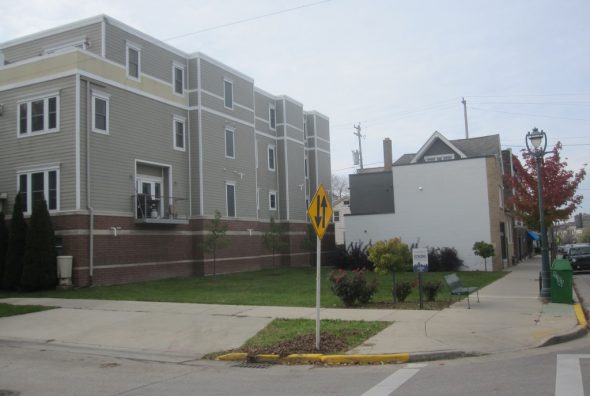
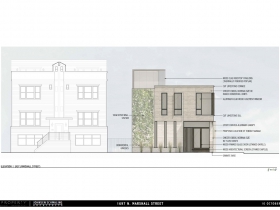
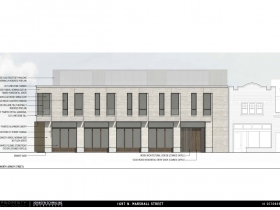
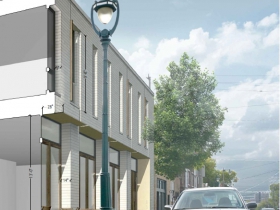
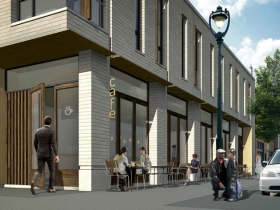

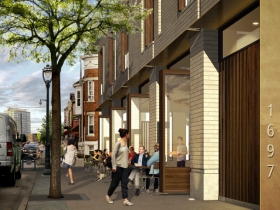
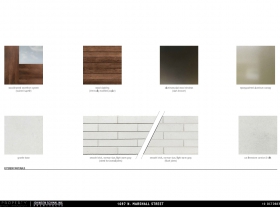
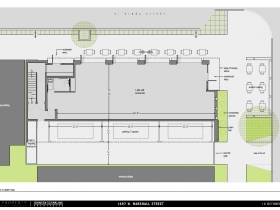
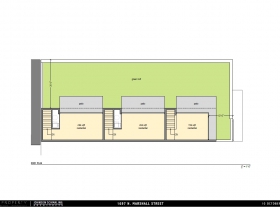
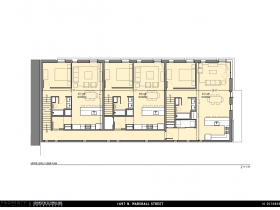
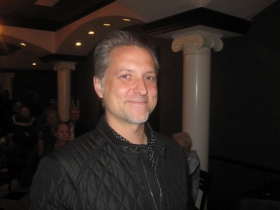
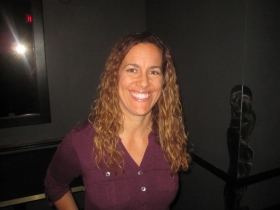
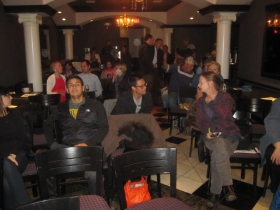
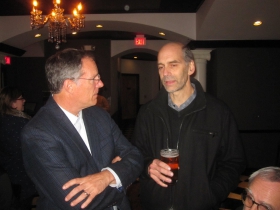
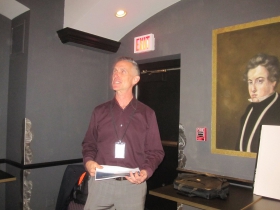
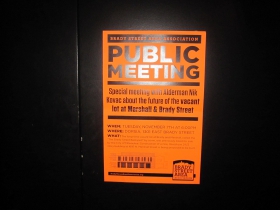




















The NIMBY knee jerk hail-mary seems to be ‘lets make it a park.’ You know, one of those things that does not generate badly needed tax revenue for our city. And in this case, this tiny space would likely be a place for dog’s to poop and little else.
I agree with Adam..
Thank you, Adam. Why in a city with so many underfunded, under-programmed and underutilized parks is there always a default call for more parks, oddly only when when a potential development is on the horizon? This interest and motivation never seems to manifest when it comes to improving the current ones. Over the 25 years that this site was vacant, I never heard of interest in a park there. A similar discussion is going on about the Bradley Center site. Urban parks only work when there is a dense urban area around them from which to escape. What is the philosophy here? That we need new parks as an escape from the surrounding bad parks and surface parking lots? Doesn’t make a lot of sense to me.
Well if Adam, Ed and Franz were involved with the Brady Street Area Association they would know that there have been efforts to turn that space into a park for years. Long before anyone showed any interest in developing there. It has only been within the last couple that funds were acquired to make use of the lot as a de facto park. The call for a park has nothing to do with the specific project.
Chris, please take a look at Friends of Milwaukee’s Downtown Forest on Facebook. Those who” call for a park” might be interested in this concept. Those who favor development of tax base at all costs – say of livability and resilience, heat island mitigation, air quality – perhaps, we could have a conversation there also?
https://www.facebook.com/groups/538772856327700/
Clarification RE: “Kovac pointed out that there was a public space two blocks to the west, in a little triangle donated by Mike Mervis and Mary Ellen McCormick, as well as the Swing Park beneath the Holton Viaduct Marsupial Bridge.”
I was told that the Mervis-McCormick triangle is actually only a temporary park. Mervis and McCormick indeed donated the plantings and continue to tend them. However, the city-owned parcel is not protected as parkland and thus could be developed.
The Swing Park is officially a city park and protected as such.